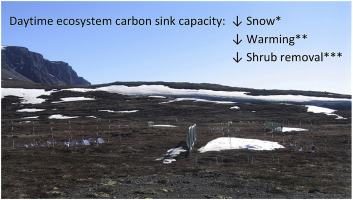Soil Biology and Biochemistry ( IF 9.8 ) Pub Date : 2019-12-20 , DOI: 10.1016/j.soilbio.2019.107698 Nynne R. Ravn , Bo Elberling , Anders Michelsen

|
Northern latitude tundra heaths have accumulated large amounts of organic carbon (C) in the soil. Changes in climatic conditions such as temperature and winter precipitation might affect the C balance and potentially change these tundra ecosystems from being C sinks to sources of CO2 emitted to the atmosphere. However, studies on C fluxes with single and combined winter snow and summer warming effects are scarce. This study investigates gross ecosystem production (GEP), ecosystem respiration (ER), net ecosystem production (NEP) and carbon isotopic composition of CO2 emitted from a dry heath in arctic Greenland one and two years following field manipulations of summer temperature, shrub abundance and winter snow depth. Our aims were to quantify climatic change effects on CO2 fluxes and the growing season carbon balance of the ecosystem and to investigate shifts in δ13C of emitted CO2 potentially due changes in emission from old soil C versus recently fixed carbon. Ecosystem CO2 fluxes and δ13C-CO2 were measured using closed chambers, and soil CO2 concentrations and δ13C were measured depth-specifically using gas probes.
We found a significant increase of CO2 emissions in all treatments during both years. Growing season NEP increased by 38 and 73% with 1 m enhanced winter snow depth, by 113 and 144% with summer warming and by 61 and 320% with total shrub removal in 2013 and 2014, respectively. The snow effect can be explained by the delay in the onset of growth as indicated by early season reduced vegetation greenness. The effect of warming was a result of an increase of ER by 39 and 32%, and the effect of shrub removal was mainly due to a reduction in GEP by 34 and 48%, in 2013 and 2014, respectively. Furthermore, the δ13C of the carbon source of CO2 emitted from warmed plots increased significantly two years after the experiment was initiated. This might indicate increased decomposition of 13C enriched soil organic matter and hence increased mineralization of the old carbon stock in the soil under warmed conditions. The increase of NEP, the additive response of all treatments, and the indications of increased emission of carbon from old stocks due to warming (or warming-induced drying), demonstrate the risk of a relatively fast feedback to climate warming during the snow-free season.
中文翻译:

通过实验性除雪,夏季变暖和灌木清除来控制北极土壤的碳转换
北部纬度的苔原荒地在土壤中积累了大量有机碳(C)。气候条件的变化(例如温度和冬季降水)可能会影响碳平衡,并有可能将这些苔原生态系统从碳汇转变为向大气排放的CO 2来源。然而,很少有关于具有单一和组合的冬季降雪和夏季变暖影响的碳通量的研究。这项研究调查了在夏季温度,灌木丰度的田间操纵后一年和两年内,从北极格陵兰岛的干旱地带排放的生态系统总产量(GEP),生态系统呼吸(ER),生态系统净产量(NEP)和CO 2的碳同位素组成。和冬天的雪深。我们的目标是量化气候变化对二氧化碳的影响2个通量和生态系统的生长季节碳平衡,并调查在δ位移13的排放COÇ 2在发射从旧土壤碳与最近的固定碳可能是由于改变。生态系统CO 2通量和δ 13 C-CO 2中使用封闭腔室测定,土壤CO 2浓度和δ 13测定Ç深度特异性使用气体探针。
我们发现在这两年中所有处理中的CO 2排放量均显着增加。2013年和2014年,生长季节的NEP分别增加了38%和73%,冬季积雪深度增加了1 m;夏季变暖时分别增加了113%和144%;夏季除草总量增加了61%和320%。降雪可以解释为生长开始的延迟,如早期季节植被绿度下降所表明的。变暖的影响是ER增加39%和32%的结果,而灌木清除的影响主要是由于2013年和2014年GEP分别减少了34%和48%。此外,δ 13 CO的碳源Ç 2在实验开始两年后,变暖的地块排放的水量显着增加。这可能表明富含13 C的土壤有机物的分解增加,因此在温暖的条件下土壤中旧碳库的矿化增加。NEP的增加,所有处理的累加响应以及由于变暖(或变暖导致的干燥)而导致旧库存碳排放增加的迹象表明,在无雪期间相对较快地反馈气候变暖的风险季节。











































 京公网安备 11010802027423号
京公网安备 11010802027423号